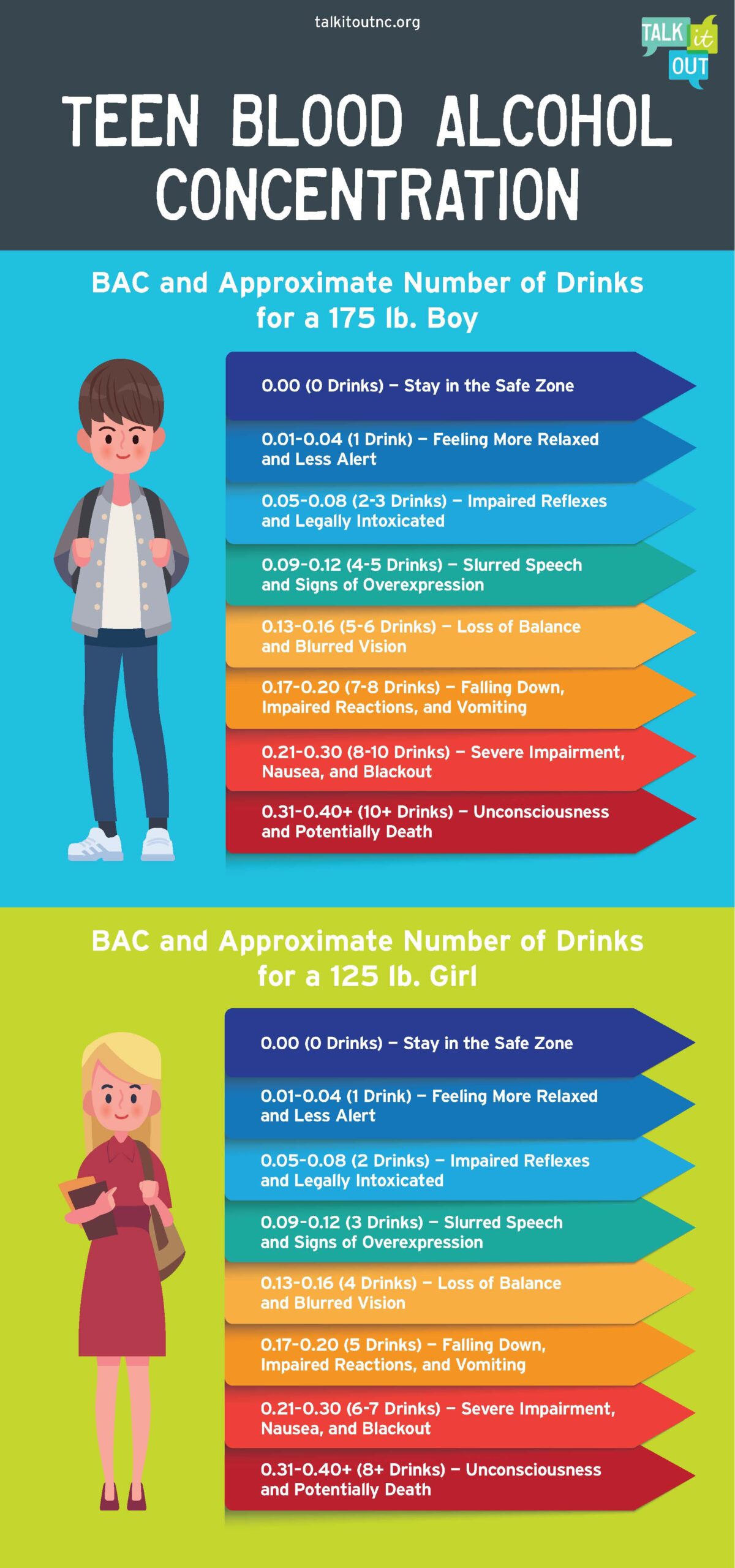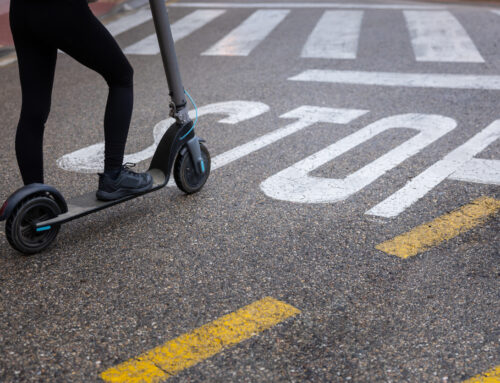Explaining Teen Blood Alcohol Concentration: A Visual Guide


Blood Alcohol Concentration (BAC) is a term that many teenagers are familiar with, but they may not know exactly what it means and how it impacts them. How much do teens really know about BAC, its effects, and what it means for their health and safety?
Your teen may know that 0.08 is the legal limit in North Carolina at which it is illegal for persons 21 and over to operate a vehicle. But what about the levels leading up to legal intoxication? What happens to teens after their blood alcohol levels go above this point?
Alcohol Affects Everyone Differently
There is a lot that goes into how the body processes alcohol and the effect that it has on someone. There are many factors that make a big difference. These include biological sex, weight, how much someone has had to drink, and how quickly they have consumed alcohol.
This is one of the reasons why teen binge drinking is such a problem across America. Excessive alcohol consumption in a short amount of time can lead to a spike in blood alcohol levels, which can result in dangerous consequences.
The effects of alcohol on teens are different than the responses of adults. That’s why it’s so important for teenagers to know the signs to watch out for and what to do when they recognize these symptoms. Here is what teens need to understand about blood alcohol levels, how they affect them and their friends, and what you can do to recognize the dangers and stay safe.
0.00 – Stay in the Safe Zone
If someone is under the age of 21, then 0.0 is the only BAC they should ever display. A 0.0 BAC means they are stone-cold sober and safe to operate a vehicle. Anything over this limit will earn them a DWI.
That’s right, even a blood alcohol level of 0.01 counts as driving under the influence and can land young people in serious trouble when they are caught.
0.01 – 0.04 – Starting to Feel Relaxed and Less Alert
Between 0.01 and 0.04 is when most people begin to notice the effects of alcohol. It’s important to remember that anything above 0.00 is illegal when someone is underage. That means blowing an 0.01 will still land them a DUI.
Other effects of alcohol felt early on include a sense of relaxation and wellbeing. This may also be when reasoning and logic start to be impacted.
0.05 – 0.08 – Impaired Reflexes and Legally Intoxicated (If Over 21)
Once someone’s blood alcohol level nears 0.05, the effects of alcohol become much more pronounced. At this point, a person may start to notice a greater lack of inhibitions as well as a shift in their balance and motor functions.
In North Carolina, 0.08 is the legal limit at which it is illegal to operate a motor vehicle for people who are over 21 years old.
0.09 – 0.12 – Slurred Speech and Signs of Overexpression
After a person’s blood alcohol concentration reaches 0.09, you really start to see the marked effects of alcohol. Regular conversations and speech may become slurred, or someone may become confused or have difficulty keeping a train of thought.
You may start to see signs of overexpression. This might include a lack of volume control, exaggerated gesticulation, like waving their arms, or saying inappropriate things they would never say when sober.
For many adults, this may be when they start to become sleepy. However, alcohol impacts the brains of adolescents differently than adults. Where an adult may become sleepy, a young person may become more energized and boisterous, leading to dangerous behaviors.
0.13 – 0.16 – Loss of Balance and Blurred Vision
When a person’s blood alcohol concentration begins to reach the levels of 0.13 and above, the problem should be apparent to everyone around them. This is when a person’s balance, mobility, coordination, and vision are all impacted by alcohol.
People at this blood alcohol level may also start to become overly emotional. This can manifest itself in extreme feelings of enthusiasm, sadness, or even anger. They may try to start fights with people with little to no provocation.
0.17 – 0.20 – Falling Down, Impaired Reactions, Possible Vomiting
At a BAC of 0.17 or greater, the impact on balance and mobility becomes even more recognizable. This is when many people begin to fall down or have trouble standing on their own. It is at this level that people may also experience nausea, which is the body’s way of trying to cleanse itself of the toxins it is unable to process.
When people talk about the stereotypes of being “falling down” drunk, this is the general BAC to which they are referring. These symptoms may express themselves as someone stumbling, tripping, or otherwise appearing “sloppy.”
0.21 – 0.30 – Severe Impairment, Nausea, and Blackout
Once a person’s blood alcohol concentration goes above 0.21, they are putting themselves at serious risk of both immediate and long-term consequences. It is at this point that someone may have a memory blackout and lose their ability to recall events that are happening.
Worse, someone with this level of blood alcohol concentration is also at serious risk of losing consciousness.
0.31 – 0.40+ – Unconsciousness and Potentially Death
Hopefully, you won’t be in a position where someone has a BAC of higher than 0.31. At BAC levels of 0.31 and higher, you should contact an emergency service or medical professional immediately.
If someone’s BAC reaches a level of 0.31 or higher, they are more likely to become unconscious. When unconscious, they may be difficult to rouse and could fall into a coma. What’s more, both breathing and heart rate become impacted at this level, leading to a higher chance of death.
Understand BAC and the Steps to Take to Stay Safe!
Understanding blood alcohol levels and the impact they have on the teenage brain and body is important when it comes to staying safe. If your teenager or someone they know begins to experience any of these symptoms, the best course of action is always for them speak with a person of authority (like a parent, teacher, or other adult). Also, contact emergency medical services.
Don’t let the lives of teens and their friends be determined by their blood alcohol concentration. Take the pledge to Talk it Out with your teen and stop underage drinking together!



